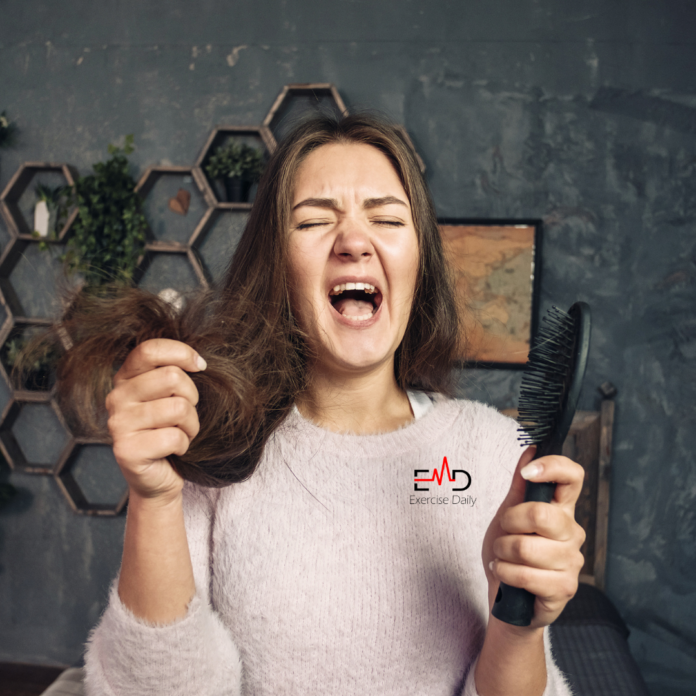Table of Contents
Exercise Daily – A lot of people ask how to increase melanin in hair? Well, there are a lot of natural ways to increase melanin production in hair.
One of the best ways to increase melanin in the hair is by meeting your body’s vitamin needs. Melanin insufficiency is connected with a lack of certain vitamins. As a result, you must increase your vitamin consumption, either through food or vitamin pills, to compensate.
Vitamins A, C, and B12 are the most important vitamins for increasing the formation of melanin in your hair and skin.
Include citrus fruits in your diet, such as oranges, grapefruit, pineapple, and melon. Eat vegetables as well, such as potatoes, carrots, beans, and so on. If you’re not a vegetarian, you can experiment with other foods such as red meat, chicken liver, fish, and eggs.
What Exactly Is Melanin?
In humans, melanin is a pigment generated by melanocytes that is responsible for the color of our natural hair. Melanocytes become less active and cease to produce melanin as a result of the passage of time, resulting in grey hair.
However, there are a number of additional factors (covered later in the article) that might influence the amount of melanin in your hair and the color of your natural hair. Melanin is classified into three types:
- Eumelanin
- Pheomelanin
- Neuromelanin
The pigments eumelanin and pheomelanin, which are found in the epidermis and are responsible for your natural skin and hair color, are the most abundant.
So, moving forward, let’s take a look at some other ways to increase melanin production in your hair.
How To Increase Melanin In Hair – Natural Ways

Following are some of the natural ways that can help you to increase melanin production in your hair:
Foods Rich in Iron
Iron assists in the formation of melanin in the hair by stimulating the creation of melanin. Dark green vegetables such as spinach, legumes, broccoli, quinoa, tofu, dark chocolate, fish, bananas, tomatoes, soybeans, lentils, and nuts also help to prevent white hair.
Moreover, seeds such as cashews, peanuts, flax seeds, pumpkin seeds, and so on are high in iron. In terms of other nuts and seeds, cashews, peanuts, flax seeds, and pumpkin seeds are also rich in iron.
Minerals
Minerals are just as vital as vitamins in terms of overall health. If you are experiencing premature hair greying, you should consider increasing your iron and copper intake to prevent further damage.
Both minerals have been shown to be beneficial in increasing the amount of melanin in your hair. Dark green vegetables, almonds, peanuts, dark chocolate, and lentils are all excellent providers of iron and minerals, as are many other foods.
Antioxidant-Rich Foods
A wide variety of meals are high in vitamins that promote hair growth. This diet is mostly comprised of foods that have high quantities of antioxidants, which have been shown to stimulate melanin formation.
Antioxidants have an additional benefit in that they help protect your cells from the destructive effects of free radicals.
Dark chocolate, blueberries, leafy greens, walnuts, beans, and artichokes are examples of foods that are high in antioxidants. So, eating antioxidant-rich foods can help with how to increase melanin in hair.
Catalase
In all living species, including plant-based foods, catalase is an enzyme that assists in the breakdown of dietary fats. It performs its antioxidant function by neutralizing hydrogen peroxide, which is a powerful oxidizing agent in the body.
The natural breakdown process of hydroperoxide results in the formation of hydrogen and hydroxyl radicals, which assault healthy cells. In reality, oxidative damage to the hair is a contributing factor to the greying of the hair’s color.
Hydrogen peroxide accumulates in hair follicles over time, causing oxidative stress on the melanocytes to become activated. A result of this is that the melanocytes are destroyed, and they are unable to create enough melanin to keep your natural hair color in place.
Catalase, on the other hand, can counteract this process. It functions as a catalyst in the decomposition of hydrogen peroxide into hydrogen and water, both of which are non-toxic to hair cells and do not interfere with the formation of melanin.
Increasing your catalase intake can be accomplished by eating more vegetables such as sweet potatoes, onions, spinach, celery, cucumber, and kale.
You can also increase your catalase intake by eating fruits such as pineapple, cherries, apricots, watermelon, and peaches. If you want to know how to increase melanin in hair, keep reading the rest of the methods.
Black Tea
Black tea is famous among hair care enthusiasts because of its advantages for darkening hair and adding gloss to locks, among other things. Because of its inherent antioxidant and tannic acid content, it is an excellent choice for preventing premature hair thinning.
Reduce Stress
Psychological stress may be a contributing cause to the loss of pigmentation and early greying of the hair. It is important to attempt to relax after experiencing a stressful scenario.
If you are unable to manage stress, get assistance and speak with a therapist. Spend quality time with your family and friends, and indulge in activities such as traveling, listening to music, yoga, meditation, exercising, or any other hobbies that will help you to calm your mind.
Copper
By eating cereals, organ meats, and shellfish on their own, you can reach half of your necessary copper consumption, and you can make up the difference by including nuts and seeds in a well-balanced diet.
Avocados, liver, oysters, and avocado oil are some of the greatest copper-rich foods to include in your diet. Other copper-rich foods to include in your diet include chickpeas, dark chocolate, almonds, cashews, sweet potatoes, avocados, poppy, or sunflower seeds.
Adding copper to your diet can help with how to increase melanin in hair.
Biotin
One of the water-soluble vitamins that promote hair development is biotin. Premature hair greying is frequently connected with a deficiency in biotin.
As a result, increasing melanin synthesis by increasing the amount of biotin in your diet or by taking biotin supplements might be beneficial.
Causes Of Melanin Deficiency and Graying of Hair
Genetics
When it comes to things like your mother’s beautiful cheekbones or your father’s height, genetic variables may be entertaining to discuss. However, when it comes to things like premature white hair, genetic factors might be a little less enjoyable.
Unfortunately, there is a strong correlation between early white hair and heredity, and there is little you can do about it.
A 2016 study of people of European, Native American, and African origin discovered a gene that experts believe is responsible for 30 percent of grey hair in persons of European, Native American and African descent. Individuals with lighter hair tones are also more likely to carry this gene than others.
Smoking
Smoking and other unhealthy habits have a role as well. Lighting up is believed to accelerate the aging process of the skin and can cause premature greying. According to research conducted in 2013, persons who smoke cigarettes had more grey hair before the age of 30.
So, if you want to know how to increase melanin in hair, then you must first give up smoking.
Stress
Isn’t it true that your parents used to remark, “You kids are making my hair grey?” It’s possible that there’s some truth behind this.
Due to the fact that stress depletes melanocyte stem cells, it is believed to be a contributing factor to premature white hair (which helps create hair color).
Recently, researchers discovered that mice that had been subjected to stress had fewer melanocyte stem cells in their hair follicles than mice who had not. The mice’s melanocytes generated less pigment the more stressed they were.
Alopecia Areata
It is possible to have hair loss due to alopecia areata, an autoimmune illness. It can also cause regrown hair to lose color in rare circumstances due to a lack of melanin in the hair shaft.
Vitiligo
Vitiligo is an autoimmune illness that causes patches of the skin to lose their pigmentation. It affects around one percent of the world’s population. This can also affect hair-bearing areas of the body, causing the hair to become white or grey in color.
Thyroid Disorders
Hormonal changes caused by thyroid diseases such as hyperthyroidism or hypothyroidism, as well as other factors, might contribute to the premature appearance of white hair. Treating thyroid disorders can help with how to increase melanin in hair.
The health of the thyroid gland has been shown to have a significant impact on hair color. Thyroid dysfunction, whether it is caused by over-or under-activity, can cause your body to produce less melanin, which is required for colored hair.
Deficiencies in Vitamins
Vitamin B-12 is the most powerful of all the vitamins. It not only provides you with energy, but it also helps to promote hair development and hair color.
B-12 is essential for the proper functioning of red blood cells, which transport oxygen to all of the other cells in your body, including your hair cells. A deficiency in vitamin B-12 can interfere with melanin formation, resulting in the loss of color.
Pernicious anemia, by the way, can occasionally be the cause of a vitamin B-12 shortage. This illness makes it hard for your body to absorb the vitamin B-12 that it needs in order to produce enough healthy red blood cells to keep you healthy.
Vitamins B-6, D, and E, as well as biotin, are also essential for good hair health. A deficit in the mineral copper can also impair melanin formation, which can result in greying of the hair.
Oxidative Stress
When your body has too many free radicals and not enough antioxidants, this is called oxidative stress. Free radicals are unstable molecules that can cause disease and aging. Antioxidants can’t stop free radicals from doing their damage because of the imbalance.
Oxidative stress, according to some research, may also have a role in the aging of hair follicles.
Best Products to Increase Melanin In Hair
Following are some of the products that can help you with how to increase melanin in hair:
M & H Melanin Multi-Use Softening Leave-In Conditioner
Designed to soften and smooth your hair while also rapidly detangling knots and assisting in the healing of your hair from roots to ends, this leave-in conditioner is a moisture-rich formula.
ProVitamin B5, Bamboo Extract, Wheat Amino Acids, and Hydrolyzed Wheat Proteins are included in this formula since they are some of the most efficient agents on the market for strengthening and conditioning hair.
SugarBear Hair Vitamins
It is based on clinical experiments that have proved that the elements in this vegan mix may help enhance the health of one’s hair.
With these cruelty-free gummy bear hair vitamins, you can nourish your hair from the inside out.
Biotin (5,000mcg) with Coconut Oil
Infused with cold-pressed Extra Virgin Organic Coconut Oil, this supplement contains high potency Biotin (5,000mcg).
Individuals who are lacking in biotin may benefit from supplements that promote healthy hair, skin, and nails. Do not use if you have acne or are prone to acne.
Disclaimer
Exercise Daily Magazine always encourages its readers to use supplements with the prior approval of their physician. So, consult with your physician or doctor before taking the supplements mentioned above.
How To Increase Melanin In Hair – FAQs
Can melanin be increased?
According to some research, increasing your consumption of certain nutrients may help you produce more melanin. It may even have the effect of increasing the quantity of melanin.
Which food can increase melanin in hair?
Foods like crabmeat, almonds, lentils, peanuts, beef liver, and white mushrooms can increase melanin in the hair.
Can biotin reverse GREY hair?
There are numerous advantages to taking biotin. It increases hair growth, treats hair loss-related disorders, and thickens and strengthens the hair as a result of its use.
Another one of Biotin’s many good effects is that it has the ability to reverse premature greying of the hair.
Conclusion
So now you know how to increase melanin in hair. To conclude everything we discussed in this article, you should maintain a proper diet to get the necessary vitamins for your hair.
Melanocytes cease to produce pigment or melanin, and as a result, the hair begins to turn grey or white.
The usefulness of melanin supplements, both orally and topically applied, has not yet been demonstrated in a scientific study.
The most effective strategy is to consume nutritious meals that are abundant in antioxidants, protein, and copper. The vitamins B12 and B6 may also help to prevent premature greying of the hair.
Share with all of us how you tackle white or gray hair.









